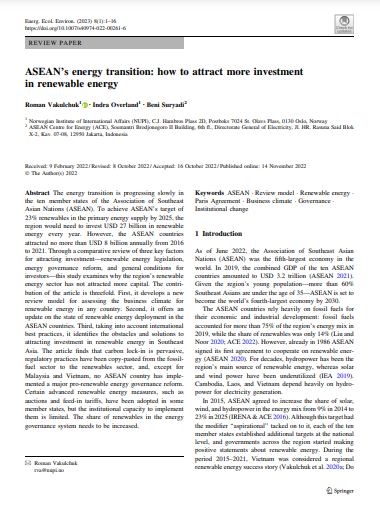
Category
Tag
Project
Author
Roman Vakulchuk, Indra Overland and Beni Suryadi
The energy transition is progressing slowly in the ten member states of the Association of Southeast Asian Nations (ASEAN). To achieve ASEAN’s target of 23% renewables in the primary energy supply by 2025, the region would need to invest USD 27 billion in renewable energy every year. However, the ASEAN countries attracted no more than USD 8 billion annually from 2016 to 2021. Through a comparative review of three key factors for attracting investment—renewable energy legislation, energy governance reform, and general conditions for investors—this study examines why the region’s renewable energy sector has not attracted more capital. The contribution of the article is threefold. First, it develops a new review model for assessing the business climate for renewable energy in any country. Second, it offers an update on the state of renewable energy deployment in the ASEAN countries. Third, taking into account international best practices, it identifies the obstacles and solutions to attracting investment in renewable energy in Southeast Asia. The article finds that carbon lock-in is pervasive, regulatory practices have been copy-pasted from the fossilfuel sector to the renewables sector, and, except for Malaysia and Vietnam, no ASEAN country has implemented a major pro renewable energy governance reform. Certain advanced renewable energy measures, such as auctions and feed-in tariffs, have been adopted in some member states, but the institutional capacity to implement them is limited. The share of renewables in the energy governance system needs to be increased.
This article is published at ScienceDirect, Energy, Ecology and Environment Volume 8, February 2023, doi.org/10.1007/s40974-022-00261-6